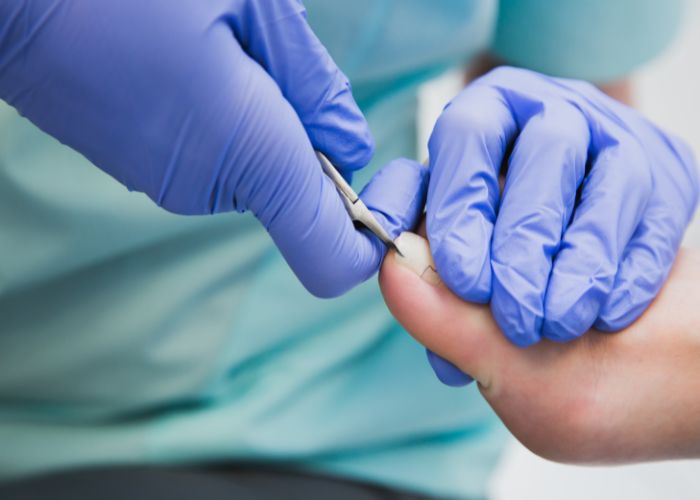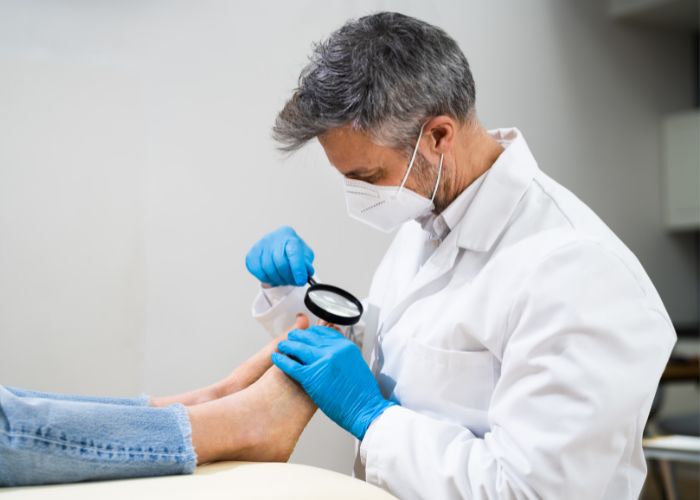
7 Treatment Options for Ingrown Toenail
Share this post:
Ingrown toenails are a common issue, particularly for persons who wear shoes that are too tight or do not allow their feet to air.
An ingrown toenail affects around 20% of the population at some point in their lives. It can cause pain and swelling in the toe. The nail might become infected at times.
Ingrown toenail treatment options range from home cures to surgery. In most circumstances, the condition can be treated at home using over-the-counter medication or home treatments. However, you should seek medical attention if the nail is infected or causing extreme pain.
The therapies listed below can help alleviate discomfort and promote the healing of an ingrown toenail.
1. Soak in warm, soapy water
Soaking the injured foot may aid in reducing swelling and relieving pain. You can soak your foot for up to 20 minutes at a time in warm, soapy water. Castile soap is an excellent choice. The addition of Epsom salts to the water may provide extra relief.
2. Use a toe protector
A toe protector, which acts as a cushioning barrier, is used to protect ingrown toenails. Toe guards are available as rings around the affected area or as a complete toe covering. Some types of toe protection, such as Dr. Scholl’s, include a medical gel to help soften toenails for easier trimming. Follow the treatment guidelines until the ingrown toenail has been removed.
3. Try a toe brace
Toe braces are thin composite devices that hold the toe in place and protect the skin against the growth of a new nail. They aid in the treatment and prevention of ingrown toenails. Toe braces are available online and at some pharmacies.
4. Apply antiseptic ointment
Using antibacterial ointment or cream can promote healing and help reduce the risk of infection. Apply the ointment to the infected toenail as the manufacturer directs, usually up to three times each day.
These ointments can include:
- mupirocin (Bactroban)
- neomycin (Neosporin)
- bacitracin/polymyxin B (Polysporin)
After application, wrap the toenail in a bandage.
5. Take an over-the-counter pain reliever
Acetaminophen (Tylenol) can help in the relief of ingrown toenail pain. Unless you take more than the daily suggested dosage of 2 325 milligrams (mg) tablets every 4 to 6 hours, side effects are uncommon. Do not take more than ten tablets in 24 hours, and avoid taking them with alcohol.
Ibuprofen (Advil) may be a preferable alternative if edema is present because it relieves both pain and swelling. Ibuprofen side effects include abdominal pain, upset stomach, and diarrhea.
All over-the-counter pain medicines should be taken exactly as advised by the manufacturer or doctor.
6. See your doctor about oral antibiotics

For a severe ingrown toenail infection that has not responded to conventional therapies and treatments, your doctor may prescribe oral antibiotics. Antibiotics taken orally assist in relieving pain and swelling while also battling infection.
7. Consider nail removal
If home treatments do not help, ingrown toenail surgery may be required. A doctor may use a local anesthetic to remove a portion of the nail’s border, the underlying nail bed, or a portion of the middle growth plate.
In severe, recurring occurrences, the doctor may urge that the entire ingrown nail be removed. This is a last-ditch effort that may be uncomfortable and raise your risk of infection. It also raises the likelihood of a malformed toenail as it regrows..
Consider nail removal
- Wedge resection. A part of the toenail is removed here to prevent it from digging into the skin. This is also known as a partial nail avulsion.
- Toenail removal. A doctor may decide to amputate the entire toenail. Removing the entire nail increases the likelihood that the nail may come back malformed or distorted, increasing the risk of future ingrown toenails. It can take up to 18 months for the nail to entirely regenerate.
- Surgery on the tip of the toe. The surgeon removes and restructures the soft tissue near the toe’s tip.
- Matrixectomy. It entails the removal of both the nail and the nail bed.



